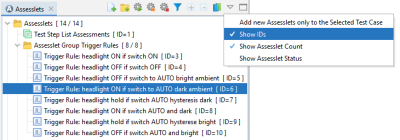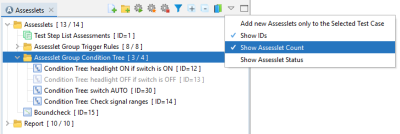Manage Assesslets
Assesslets are created, activated/deactivated, assigned to test cases and variants, grouped, or deleted in the Assesslets view, while the assesslet is specified in the Assesslet Content view.
Create an assesslet
Click ![]() Create assesslet in the Assesslets view toolbar and select the assesslet type you want to create. More about assesslet types, see Assesslet Types.
Create assesslet in the Assesslets view toolbar and select the assesslet type you want to create. More about assesslet types, see Assesslet Types.
List of assesslets
Copy an assesslet
When you copy an assesslet, the assignment to test cases, requirements, variants, report sections, and platform configurations is copied together with the assesslet. If the item the assesslet is assigned to is missing in the target project, you are informed about the missing element.
An assesslet is identified by its name. When you copy an assesslet, the assignment is copied too as long as you stay in the same project. Or as long as the target project has items with the same path name, and requirements with the same IDs, since only the link is copied
Rename an assesslet
To rename an assesslet, click once over the selected assesslet, press F2 and change the name. Click anywhere else or press Enter to confirm. Or use the menu which is accessed by right-clicking over the selected assesslet.
In case of a name conflict, you are warned when saving the project. You also get the option to change one of the names by adding a number; click Reload in the warning to change the name.
For example, if you have two Trigger Rule assesslets and name them both TriggerRule, one of those rules will be renamed to TriggerRule__001. This also affects the name of the assessment result channels shown in the Signal Viewer.
When you execute a test, the name conflict is mentioned, but you cannot reload the project at this moment. TPT changes the name of the assessment result channel to <name> (#number), for example TriggerRule (#1). In the report, the name of the assesslet is displayed as TriggerRule__001.
Reload the project (Ctrl+S) to see the renamed assesslet also in your project.
Arrange assesslets
You can arrange assesslets using a drag-and-drop operation or a multiple selection by pressing Ctrl+Right-click.
Group assesslets
You can also organize assesslets in groups.
- Click
 Add assesslet group in the toolbar of the Assesslets view.
Add assesslet group in the toolbar of the Assesslets view. - Click on the group folder to change its name.
- Use a drag-and-drop operation to place assesslets in the group.
Show assesslet IDs
Assesslet IDs are always visible in the Assesslet Content view and are always displayed in the test report's Assesslets Summary, Overview, Variables Summary, Requirements, and in the test case report. To display assesslet IDs in the Assesslets view, click ![]() Options and select Show IDs.
Options and select Show IDs.
Show assesslet IDs
To search for assesslet IDs, select the Assesslets view and press Ctrl+F to open the local search.
Show assesslet count
In the Assesslets view, you can display the number of assesslets and the number of activated assesslets which are arranged in assesslet groups. Click ![]() Options and select Show Assesslet Count.
Options and select Show Assesslet Count.
Show assesslet count
For example, the count at Assesslet Group Condition Tree [3/4] indicates that one of the four assesslets in the group is not activated for the currently selected test case. The assesslet not activated is dimmed (ID 13).
Show assesslet status
You can apply a review status to assesslets, see Test Management - Test Case Status / Assesslet Status. To display them, select the Show Assesslet Status option.
Show assesslet status
Delete an assesslet or an assesslet group
To delete an element in the Assesslets view, select the assesslet first, then right-click on it and select ![]() Delete.
Delete.
Duplicate an assesslet
Select an assesslet first, then right-click on it and click ![]() Duplicate to create a copy of the selected assesslet in the same group where the assesslet is already located. A suffix
Duplicate to create a copy of the selected assesslet in the same group where the assesslet is already located. A suffix _Copy will be placed after the name of the duplicated assesslet.
The duplicated assesslet is not linked in any way to its source, so changes in the original assesslet do not effect the duplicated one and vice versa.
Mirror the test cases structure in the Assesslets view
You can mirror the structure of the Test Cases folder or of selected test case groups or single test cases from the Project view in the Assesslets view.
To mirror the structure:
- Select a test case, test cases, a test case group, test case groups, or the Test Cases folder in the Project view.
- Right-click on the assesslets folder in the Assesslets view and choose Copy the Structure of the Selected Test Cases.
This will lead to the generation of new folders in the Assesslets view that are named after the test cases.
These are the rules applied to the restructuring:
- Every assesslet that is applied to a single test case, is placed inside a new folder that is named after the test case in the Assesslets view .
- Every assesslet that is applied to more than one test case stays in its place in the Assesslets view.
- Every assesslet that is applied to more than one test case and these test cases are part of a test case group, are placed in a folder named after the test case group.
|
Before applying the option "Copy the Structure of the Selected Test Cases" In the following example, there are five test cases and five assesslets initially placed in the folder Assesslet Group. The Step List assesslet is placed outside the Assesslet Group folder and it is active for all test cases. The five trigger rule assesslets are active for the test cases as follows: tc_a : Trigger Rule 1 tc_b : Trigger Rule 2 tc_c : Trigger Rule 3 tc_d : Trigger Rule 4 and Trigger Rule 5 tc_e : Trigger Rule 4 and Trigger Rule 5 After selecting in the Project view the Test Cases folder and in the Assesslets view the Assesslets folder, the option Copy the Structure of the Selected Test Cases will rearrange the assesslets as follows: After applying the option "Copy the Structure of the Selected Test Cases" |
Show test cases that use a specific assesslet
Right-click on an assesslet in the Assesslets view and select Used by. For more information about the usage of an element, click ![]() Show Usage, see Views - Usage.
Show Usage, see Views - Usage.
Assesslet used by test cases
You can apply assesslets to individual test cases. This is done by activating an assesslet only for specific test cases. Each activated assesslet can be deactivated for specific test cases. This is described in more detail in Activate or deactivate Assesslets.
Deactivated assesslets are displayed dimmed in the Assesslets view. Thus, when you mark a test case in the Project view, all deactivated assesslets for this test case are dimmed in the Assesslets view. You can hide disabled assesslets by activating ![]() Filter Active Assesslets.
Filter Active Assesslets.
Filter active assesslets
A new assesslet is by default active for all test cases. It is displayed for all test cases even if it is created inside an assesslet group that is only active for a specific test case.







